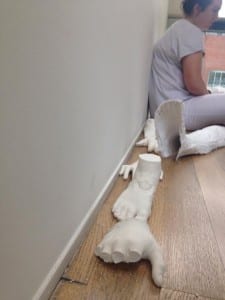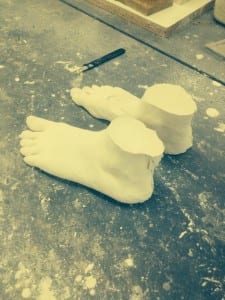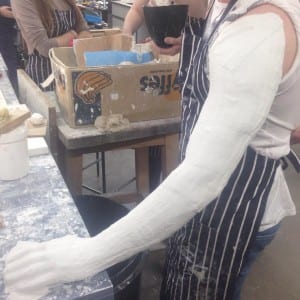The Final Blog: Set in Stone.
Eleanor McHale.
Framing Statement.
In this blog I am going to show the process and final instalment of the piece ‘Set in Stone’. Body in Architecture has constantly influenced many performers throughout the ages ranging back to the BC era with the pyramids and monuments built in Egypt and long before that. The reasoning for the piece is to show how performance built in body and arcitectecture is such a beautiful and present piece of art and history. The beginning of a performance is never thought to be about the stage and making the performance because of the stage; this is just usually a useful inanimate object where the stage is used almost like a prop. The architecture of the student university library is one of the most interesting of library’s; as the students go there to further themselves and gain experience and knowledge.
Ever since a child is born it is in and out of architecture and confide spaces without even realising it. From card board boxes, Wendy houses and play areas then into a school building where they will spend at least 13 years of your life and then into an office building or a job environment; which then eventually will end in a wooden box in the ground. No matter what the outcome or where you are in the world you are surrounded by architecture from wooden huts in Kenya to the Taj Mahal in India, although different types of buildings are still architecture.
The library is a place of learning and education and among the books lives creativity and flare. However what the students fail to realise is that the library was not always that, but a grain factory. The methodology of our ideas was that if you can fit any part of the human anatomy in a space it can be deemed as performance and it can take place anywhere. We wanted to explore what makes a space a space and how can something’s be classed as architecture that is not living yet has life inside it; yet the human body is a building that houses living organisms, so by definition is architecture on its own.
An Analysis of Process.
“All the worlds a stage; and all the men and women merely players” (Shakespeare, 2000, Act 2 S.7) The fact that you can perform anywhere at any time completely is forgotten about by performers I am guilty of doing it, thinking that you can perform in a space but not really thinking about what is actually going on in the space you are in.
What gave the group the motive for exploring the library was that you never really noticed what was going on around you and all the different places that are forgotten about. The stimulus came from images of bodies in confined spaces around the building. The performance started at every half past the hour and ran for roughly 20 minutes, this was timed by the sound that had been played and when the sound ended the actors knew it was the end of the twenty minutes. The piece was performed on the back stairs of the library; the stairs we chose were the less used stairs by the students. The stairs consisted of three floors but seven sets of stairs with 4 platforms connected to them.
Four of the group members including myself went to the Arboretum to explore confined spaces which we have never been too. Taking the trip to the arboretum started our ideas by performing on the band stand. This made us explore the many things you can do just performing for the space instead of in the space. The group originally started as a four and gained two members who came with different ideas.
The piece consisted of body moulds made with clay, alginate and mod rock cast; alongside of the performers who were casted into the library and the other half of the group walking up the stairs in different pace’s and variations of movement. But mostly we wanted the audiences reaction to what was going on, on the stairs; there reactions varied from interest in what was going on, too confusion and out right determination to ignore what was going on. All the reactions however is what we deemed would happen; it was interesting to see if the audience acted on their impulses and to see if they spoke to us in curiosity. Out of the six performers three of the performers will be mod-rocked into the building while the other three will be walking up and down the stairs.
The process began with the first exploration of the university library to access all the places we don’t usually visit or use in the day to day basis. Originally the first idea came from using the elevator as a place that you never really notice; but you use it on a day to day basis without realising. Exploring the elevator proved to be difficult as when it came to wanting to really explore it; the library staff who would be constantly transporting books to different floors on the library trolleys and needed to fit in the lift also the wait for the elevator came to be quite disheartening as people would need to use it constantly.
An exercise of exploration came with the senses task which consisted of finding a place in the library where you have never been before and choose from one of the senses to describe what is happening to you. I chose what I could hear and listened to a conversation that involved two students and their subject worries.
A: Did you do the draft for the seven questions for Thursday?
B: I haven’t yet but I am thinking of staying here tonight and doing it when Richard gets here
A: I wanted to go out tonight but.
B: I’m probably not gonna be leaving here.
A: I can’t wait for this year to be over.
This was only a snippet of the conversation but really opened my eyes into what strangers who may have no similarity’s to myself except being at the same university and in the same building with me right now. What interested me was this person was going to spend the majority of his day in this building and probably would not notice that he was sat next to a sign that mentioned some of the library’s history and the date it was built. Another interesting thing I realised was that mostly the only reason the students went in the library was for the academic reasons consisting of deadlines, essays and exams.
From there I thought of an idea of doing small performances of conversations heard in the library. But reading them as if they were from a story in a book. The complication came from if the members of the public were speaking about other students in a gossiping manner. From this I decided to move on with the sense of vision and describe everything I can see. Using a voice recorder I would describe certain parts of the library and make the audience guess which part of the library I was at. This idea stemmed from showing the audiences places they would never have thought off and also make the students finally realise their surroundings.
It only started with the body in architecture when we as a group finally explored the stairs at the back. What made the stairs interesting to me was that they were barely used. But they held so much beauty in the way that they had full length floor windows so you could see them completely from the outside. But also the people on the stairs can see out to the public which casts almost a gallery feel. The windows create a framing effect round the stairs which reminded me of live theatre this then began the idea of being part of the actual building and it being live theatre. Our first day in art consisted of using the mod rock in which casts are made off. For the first body part we mod rocked was my arm from my fingers to my elbow. As we merely mod-rocked the arm a performer was able to go in and out of the mod rock. Discovering what cast can do was one of the most interesting experiences through the process.
- The Mod-Rock (what the performer could put on): Mod- rock (Cast) and water.
- The Intricate casts (what can be used as props): Mod-Rock, Aliginate, Clay and Water
The reasoning for using the mod rock was to show that all the props were linked; from the feet and hands to the books that we stored on the stairs shelves. The alginate creates a more detailed cast where you can see veins and the intricate characteristics of the body parts.
The body in Mod-Rock, was an idea that transpired with the library and not only ended with just the body as mod rock but we used books as well; but had to do these differently to the other items. We had to use latex and a straw like substance to keep the books intact. “If we are going to try to find ways in which mimesis in architecture might promote a questioning of societal norms and prevailing ideas about reality” (Rufford, 2015, p. 20) this then made us question what the books meant to be when mod-rocked. What the group thought would be a nice image was to leave the mod-rocked books on the shelves to see if anyone touched them or in fact noticed them after. Firstly we started Mod-rocking the groups hands and then we moved on to feet which worked better in my opinion as it was a little more detailed. The books came around to be difficult as they were covered in latex and would need a natural light so they took longer to dry.
The use of the other three performers was that to mimic the students walk up and down the back stairs. The variations of pace and style escalated from a dance like pace. Another way of walking down the stairs was the slow walk up; one of us attempted to make it up the stairs so slow it would have taken the full twenty minutes. The idea of the slow stairs crawling has come from a clip of an actress who crawled down a pair of stairs in a public place. The reason we wanted to do this was to explore how the students actually walk down the stairs and in rehearsal we explored how we would walk up and down the stairs. What we noticed was that the audience started mimicking how we walked. This was what we wanted to explore and even the actors started mimicking how the audience walked. What was interesting was these students who normally would not even think about getting down the stairs had an obstacle in the way. The performers ended up blocking the path of the students to make them realise that the stairs were not just a way of getting from each floor.
“Even theatre that is ostensibly unconcerned with architecture is powerfully conditioned by it none the less” (Rufford, 2015, p. 3) This was quite important as when we considered doing our piece on the stairs it was not completely in our minds how the mod rock would look in the stairs it was more about how the mod rock could enhance the beauty of the stairs. In this we realised that the stairs did not need a massive performance, we could have even left the casts just laid around the stairs and it still would have made the students stop and notice the stairs a little more. The reasoning of having the live performance of walking up the stairs was more for a personal reflection on the ways that we as humans do not realise the simple privileges we have all around us.
The costume we chose to wear was a white outfit that consisted of white tee shirts and white jeans to blend in with the white walls. This was chosen because we wanted to become part of the building. This worked well due to the white casts that were on arms and feet. The group’s hair was scraped back to hide the sexuality and personification of who we were; however we did not want to look theatrical with too much white. Body image was very important as our faces were drawn blank and the only way we could communicate with the body.
In one rehearsal we went to the stairs and just listened to everything we could hear around us; from the clicking of a keyboard on the library floors, too doors slamming, people chatting and generally just the sound of life. So I thought wouldn’t it be great if you could make the audience hear these sounds and realise what was going on around them that they didn’t even notice. The sound scape consisted of people walking up the stair and muffled voices what the aim was is to create a sound that if you closed your eyes you could take a guess as to where you were.
An issue arose when we could not decide as a group where we wanted to start our piece between the elevator, the stairs or the free space we did at one point try using all three of them however it helped as another group used the free space. This by process of elimination and as well of a certain spark towards the back stairs made the first move.
Personal Evaluation.
My overall opinion on the final performance; I think went really well due to the work ethic of the group. Originally when we first got into a group of six we all had found different places in the library that we wanted to further explore so this started the idea of interpreting all the different ideas into one. But the process really was a long but rewarding one; however it came with its great difficulties. At one point we were unsure if we were going to have enough alginate from the order we had made and if we needed more we wouldn’t have time to make more body casts. However we over budgeted and had some left to give to the art department. What I think went well was that in the group each member of the group all brought something different in ideas and opinions.
In the final piece we did three performances; where three members of the group started by being mod rocked into the building I was in the first group to be part of the building on third floor. I had my feet casted into feet moulds so I could slip them on and off; I had a foot mould in my hand to portray a gallery type feel. The first piece went well the issue I found was that people tried to talk to me to ask what I was doing but I could not reply. After the first twenty minutes I made my way to the group; as the stairs are opposite windows into the library and I could see students looking into the stairs with curiosity. When the second performance commenced we realised we had the least amount of audience members. In this the first time I walked up the stairs I walked with my legs kicked behind me to show the effort foreshadowing the workers from the grain factory. I then used the face cast in my walk up and down the stairs at one point I held it in front of my face to juxtapose wearing a mask. I shaped the mask around my body and tested it with different styles of walking. This was to show that slowly even my face was being taken over by the library. In our final piece we adapted the book casts into our piece to show that the body was part of the library. The books were moved from the shelves; I placed the books under me to use as a pedestal to mark the library being all around the students. Overall I feel like the audience understood why we were doing the piece to notice the beauty of the stairs. But more importantly I feel it opened my eyes to what a performance space is and how it can be used.
Bibliography:
- Rufford, J. (2015) Theatre & Education. London: Palgrave. P. 3-15
- Shakespeare, W (2000) As You Like It. NEW YORK: BARTLEBY.COM. Act 2; Scene 7.


